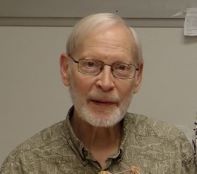
George Emil Bruening
Professor of Plant Pathology, Emeritus
George E. Bruening, Professor of Plant Pathology at the University of California, Davis, passed away on December 2, 2023. George was born in Chicago, IL on August 10, 1938, and grew up in South Milwaukee, WI. He earned his Bachelor of Science in Chemistry, Summa cum Laude, at Carrol College in Waukesha, WI. He then earned his MS and PhD. degrees in Biochemistry from the University of Wisconsin, Madison in 1963 and 1965, respectively. He did postdoctoral work on viruses in the laboratory of Nobel laureate Wendell Stanley at the University of California, Berkeley from 1965 – 1966. He then joined the Department of Biochemistry and Biophysics at UC Davis as an assistant professor in 1967. In 1984 he joined the Department of Plant Pathology at UC Davis from which he retired in 2008. He maintained an active research program until his passing and he continued teaching at UC Davis until 2021, teaching for a total of 54 years.
George loved research and is recognized worldwide for his many outstanding contributions. He often said luck was involved in his research accomplishments, but in reality, it was his ability to recognize the important questions and then take the correct approaches to answer them. He worked for many years with cowpea mosaic virus (CPMV) and combined fundamental studies on CPMV with translational studies to prevent CPMV-induced plant disease. The CPMV particle is a small (~30 nm) icosahedron. Most other small plant viruses known at that time had icosahedral virus particles composed of many copies (usually 180) of a single protein. George and colleagues found that CPMV had 60 copies each of 2 different proteins, one of which was a fusion protein thus providing a novel way to produce a particle of 180 proteins. But CPMV can also cause disease in cowpeas. George and colleagues were interested in resistance in cowpeas to CPMV as a way to prevent disease. They screened the USDA collection of over 1,000 cowpea lines and found one that was immune to CPMV. Later he and colleagues identified the cowpea gene that conferred CPMV this immunity.
George also worked with tobacco ringspot virus (TRSV) and its molecular parasitic small RNA, satellite tobacco ringspot virus RNA (satTRSV RNA). In ground-breaking publications in prestigious journals including Science and Nature, George and colleagues showed that the satTRSV RNA had enzymatic activities embedded within its nucleotide sequence. One was the ability of multimeric forms of the satTRSV RNA to autocatalytically cleave into monomers. This was the first example of “ribozyme” activity in plant pathogenic RNAs, and was soon followed by findings of others in different RNAs.
Another of George’s very important accomplishments that blended his research and service at UC Davis was his service as Director of the National Science Foundation-funded Science and Technology Center, Center for Engineering Plants for Resistance Against Pathogens (CEPRAP). CEPRAP was a multi-disciplinary effort including many UC Davis faculty. The CEPRAP research focus was towards understanding the molecular and biochemical bases of plant:pathogen interactions and then utilizing contemporary technologies and novel strategies to protect plants from disease. CEPRAP had continuous funding (more than $20 million) from the NSF for 11 years and was a center of excellence that brought prestige to UC Davis. When discussing CEPRAP’s achievements, in addition to the research George was extremely proud of the many young scientists who trained there and went on to establish their own stellar careers.
George received numerous awards in recognition of his scientific excellence. He was awarded a Guggenheim Fellowship to support a sabbatical leave at Cornell University in 1974-75 where he and colleagues deciphered the mechanisms used by tobacco mosaic virus to regulate gene expression and protein production. He was elected Fellow of the American Phytopathological Society in 1986 and received the U. S. Department of Agriculture’s Superior Service Award in 1993. George was elected as a member of the National Academy of Sciences in 1992. This prestigious honor is only awarded to a very small percentage of excellent scientists.
George truly believed in shared governance and was very active and effective at both the University and professional levels. At UC Davis he served on numerous committees within the Department, College and at the University level. Professionally he served on committees within the American Phytopathological Society, and was one of the founding members of the American Society for Virology. He served as the first editor in chief for the highly ranked journal, Molecular Plant Microbe Interactions. As a member of the NAS, he was very active in editorial duties for the Proceedings of the National Academy of Sciences.
George was also recognized as a truly dedicated and inspirational teacher. He said several times that good teaching makes a difference, and he made a difference. He taught a number of undergraduate and graduate classes during his tenure at UC Davis. His first teaching at UC Davis was in Biochemistry. There he, along with colleagues Roy Doi, Eric Conn and Paul Stumpf wrote the textbook Outlines of Biochemistry, 5th edition, a textbook that was used worldwide. After moving to the Department of Plant Pathology, he mostly focused on teaching graduate plant virology (PLP 230) and undergraduate general virology (MIC 162). His lectures were always carefully crafted, and his enthusiasm for the subject matter was contagious. He had the ability to clearly present difficult concepts so all could understand. He knew how to get students to think about the subject at hand, and his exam questions were always thought provoking.
George was selected in 1999 to be the 57th Faculty Research Lecturer at UC Davis. One of the quotes given in the announcement for that lecture said “Professor Bruening is one of the world’s great virologists. Certainly, he ranks in the top five in plant virology, and within the top 25 in all of virology. In spite of this, he is actually quite a nice person.” He truly was.
David Rizzo
Bryce Falk
Valerie Williamson
